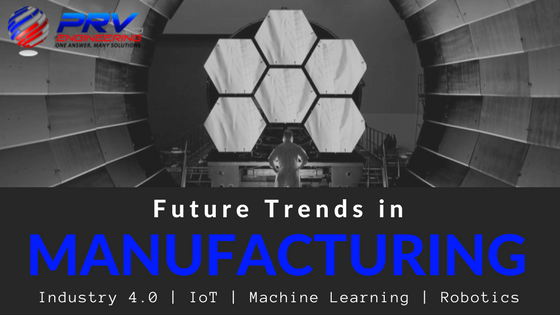
The correlation between manufacturing trends and our economic growth is crucial. But how do we ensure innovation, competitiveness, higher income and improved quality of life? No surprise here as the answer lies in manufacturing. Investments in this sector impact the economy through job creation and career growth in other industries as well.
As we enter the fourth industrial revolution, the role of technology increases and so do the skills required to work in the industry. Automation in itself seems to be a hotly debated topic. Some believe it’s the answer to a more efficient workforce where others believe it will replace more and more workers every day. There should be a balance between the two as human intervention, as some believe, is and will always be necessary. Focus should also be on further education and training of workers to prepare them for the future of manufacturing.
Manufacturing Trends of tomorrow
There are many future opportunities in manufacturing such as additive manufacturing, robotics, artificial intelligence (AI), internet of things (IoT) as well as new materials which could bring substantial benefits to everyone.
Industry 4.0 is revolutionizing manufacturing and here are five main points of interest:
1. The future of printing in 3D
3-D printing has been around for some time but technological advancements have streamlined the industry. The mass production implications are extensive ranging in products from toys and construction to medical devices. Seamless creation of products is now possible using a single and faster machine. Some products may require numerous parts but 3-D printing can achieve the same result with only one piece.
2. Virtual Production Simulations
New technology is allowing companies to simulate the production process. This virtual simulation includes all the stages of production from concept and design to assembly and packaging. This greatly helps cut down on manufacturing time and also ensures that the manufacturing process delivers what is intended. Almost like a beta test before real implementation.
Companies are also using augmented reality (AR). AR glasses are one example how to expedite problem-solving and as a result, greatly reduce travel costs. This takes remote assistance to whole new level as it allows for real-time communication between people in different locations around the world. An engineer in Europe can assist someone in Kenya relaying real-time visual data. It will seem as if they are on site together which increases accuracy of the process.
3. Cloud Computing and Intelligent Factories
Factories are implementing cloud computing and smart sensors that can convert data into different units of measurement. They can also communicate with other machines, record statistics and shut off devices if required. Cloud computing enables the extraction, analyzing and reporting of information related to the production line. Data from these technologies, along with increased customer feedback, significantly impacts research and development. The end-users are provided with more of what they want, faster delivery and lower costs. This is the ultimate system that will only drive innovation even further.
4. Advanced Manufacturing Trends and Automation
Adoption and market growth of industrial automation is on the rise and will continue to grow. Many companies have already implemented automation to some degree. As a whole, automation enables improved accuracy and productivity beyond any human ability. New technology has made robotics easier to program and easier to use with voice and image recognition making complex human tasks seem simple to replicate.
5. Robotics and Automation
With augmented and virtual reality, robotics and smart manufacturing at the forefront, what will the future workforce look like?
There are still some challenges ahead and despite the overwhelming concern of robots taking over, the outlook seems mostly positive. Contrary to popular belief, the bulk of automation is used for work that would be deemed unsafe or impossible for humans. This, in itself, makes robots a complement to the workforce and certainly not a replacement.
Until robots can build, maintain and program themselves, which is probably not a good idea, we still need people to manage these tasks. High in demand would be those who can build hardware, software and firmware; create automation and design robotics, adapt and maintain new equipment.
As our machines become more advanced, so do our workers and products and thus follows a new era of production. Our lives have already changed beyond imagination from only a few short years ago. Manufacturing trends such as these are set to continue and there is more innovation on the horizon.
Get in touch if you need assistance with your project or if you have any questions about our precision engineering and manufacturing services.
This site uses Akismet to reduce spam. Learn how your comment data is processed.


 Mail:
Mail: 




Leave a Comments